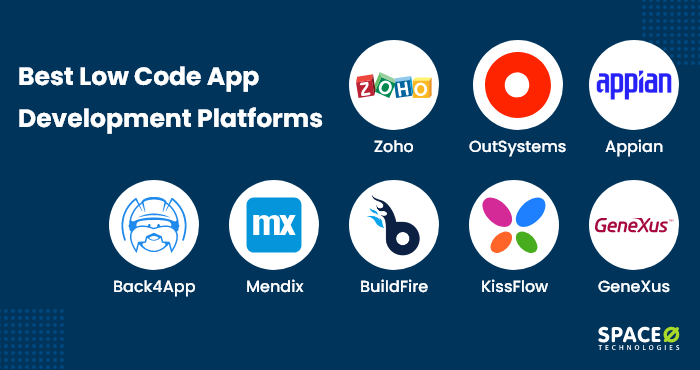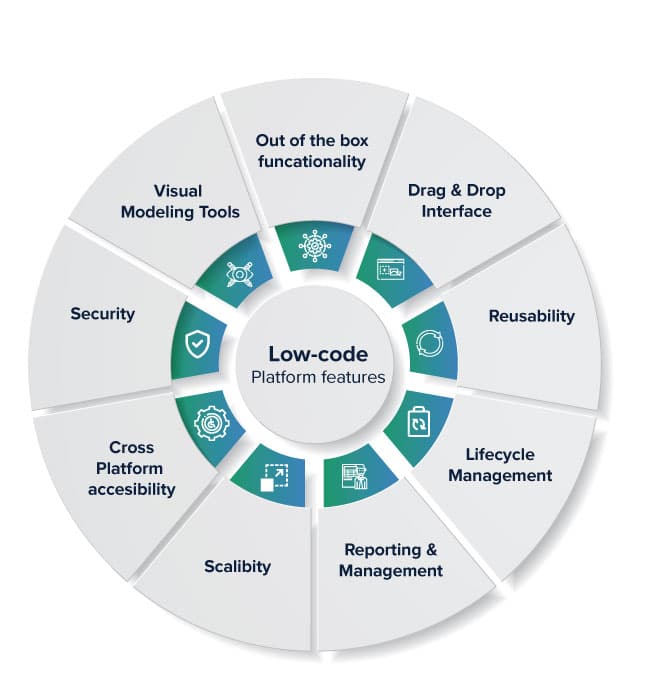New Facts For Picking Low-code platforms for application development
New Facts For Picking Low-code platforms for application development
Blog Article
Advantages Of Low Code Application Development For Developers Who Are Not Developers.
Because of a variety of reasons the development of low-code applications is more accessible for non-developers. They are commonly referred to as "citizens developers."
Drag-anddrop Builders: Lowcode platform include drag-anddrop interfaces to enable non-developers to create visually appealing applications, without needing codes. This lets development be more accessible to those with no technical background.
WYSIWYG editor: The "What you see is the result you get" editors allow users to create interfaces, workflows, and other functions in a manner that closely mimics the final result. They are simpler to learn and make use of.
Simplified design of Workflow and Logic
Visual Workflow Modeling - Users can create business procedures and logic applications using visual flowcharts and models. This is a lot more simple than traditional programming methods.
Pre-built Logic components Low-code platforms have logic components pre-built (e.g. conditional loops and statements), which can be configured easily which eliminates the need for complicated coding.
Reusable Templates and Components:
Template libraries that are pre-built: Numerous low-code platforms have a library of the most commonly used types of applications, providing non-developers a solid base that they can build upon and customize.
Reusable Widgets and Modules: Users can leverage modular and reusable widgets which can be created faster, reducing the time needed to create them and reducing the requirement for in-depth technical knowledge.
Guided Development and Tutorials
Step-by-step guide Platforms offer tutorials, tips on screen, and development guides to assist non-developers in creating applications.
Interactive Tutorials Interactive tutorials are hands-on and interactive, which help users to learn through doing. This boosts the confidence of users in the platform.
Integration with existing tools:
Seamless Integration: Low-code platforms are designed to seamlessly integrate with the tools and systems in business (e.g. the ERP or CRM), which allows non-developers, to create applications to work within current workflows.
APIs Connectors: APIs are built into applications to make integration easier. This allows non-developers, who don't have programming skills, to connect to external services.
Collaboration Features:
Team Collaboration real-time collaboration, shared workspaces, and shared workspaces allow business analysts, non-developers, and other stakeholders to effectively work with professional developers.
Access Control based on Role: Users who are not developers can be assigned specific roles and access levels. This enables them to contribute to the development without compromising security and functionality.
Automated Testing and Debugging
Test Tools Included: Many low-code platforms include integrated debugging and testing tools. These tools streamline the process, making it easy for non-developers ensure that their apps are functioning properly.
Error Highlighting - When problems occur, the system highlights them and suggests solutions, while guiding users through troubleshooting.
The ability of low-code applications to make development accessible for non-developers is its biggest benefit. With its intuitive, visually-guided tools and experiences, low code platforms allow business owners to actively participate and maintain applications. View the top rated wavemaker.com coding for website recommendations including stored sql procedures, azure sql, push alerts, driver jdbc, app modernisation, database in azure, app platforms, application development platforms, ms azure sql, develop web app and more.
Flexibility And Scalability Are The Two Primary Benefits Of Low Code Application Development
Low-code application development offers several advantages regarding the ability to scale and flexibility. These are vital to build applications that adapt to business demands and change with the demands of business. There are three benefits to low-code development.
Cloud-Based Deployment: A lot of low-code platforms use cloud technology that allow applications to scale easily with the cloud infrastructure. This allows companies to handle the increasing demands without worry about managing servers.
Auto-Scaling feature: Built-in features that automatically scale resources in order to meet demand can ensure consistent performance with no manual inputs during peak hours.
Flexible Architecture:
Modular Design: Low-code systems support modular application design, where components can be created independently, tested, and scaled. Modularity improves the flexibility of an application and makes it simpler to update or expand specific components of an application without affecting the overall system.
Microservices Integration : In support of microservices, applications can be developed using loosely-coupled services to improve capacity and flexibility.
Customizable Solutions:
Extensibility : Low-code platforms allow developers to expand capabilities beyond what is available in standard features. It allows developers to meet their own business needs without any restrictions.
Third-Party Integrations: The capacity of businesses to connect APIs and applications from third parties and add new functions to the application as needed, increases its capabilities.
Agile Development and Deployment
Continuous Delivery and deployment Low-code platforms are compatible with agile methodologies and enable continuous integration and delivery (CI/CD). This allows for rapid deployment and updates of features.
Iterative Development - The low-code approach permits applications to be enhanced and scaled up incrementally, reducing risk and allowing for more controlled expansion.
Resource Optimization
Efficient Resource management: Platform tools that use low-code assist in optimizing the use of resources by monitoring and managing the performance of applications. This ensures that resources can be utilized efficiently, and can be can be scaled up or down depending on actual requirements.
Load-balancing: Features that spread workloads equally among servers increase the capacity of applications to handle large traffic and ensure a consistent performance.
Global Reach
Multi-Region Availability: Lowcode platforms allow the deployment of applications across different regions. Companies can provide users with low-latency worldwide access. This is crucial for applications that have a global user base.
Localization Support: The built-in support of localization allows applications to be easily customized to suit different languages and requirements in different markets.
Maintenance and Updates
Simplified Maintenance : Low-code applications are modular and visual. This makes maintenance easier. This lets the release of updates and bug fixes to be made quickly, with no long periods of downtime.
Version Control: Integrated version control systems aid in managing rollbacks and changes to ensure that updates are deployed without risk and that previous versions can be restored if necessary.
Cost Efficiency:
Low-code platforms reduce development costs by reducing the requirement for extensive coding. They can also allow you to expand applications without proportional cost or effort.
Pay-As You-Go Models: Many low-code platforms offer flexible pricing models, like pay-as-you go, which aligns costs with actual usage and growth, providing financial flexibility.
The flexibility of low-code apps lets businesses develop strong, adaptable, scalable, and durable applications. These platforms enable quick adaptations to the changing requirements as well as efficient utilization of resources and continual improvement. This ensures that applications can grow with the business. See the best Legacy application modernization with Low-code blog for site advice including microsoft azure sql, rapid applications, driver jdbc, rapid action development, rapid application design, rapid applications, rad application development, application development platforms, develop web app, rad application development and more.
The Benefits Of Low-Code Development For Developing Applications In Terms Of Limitations And Customization
Low-code application design is a balanced, flexible approach that overcomes limitations and allows for customisation. Here are some benefits:
Overcoming Complexity Barriers
Simple development: Platforms that use low-code reduce the amount of work by supplying templates and components pre-built for you which allow faster development and deployment even for complex applications.
Guided Workflows: A lot of platforms provide guided workflows and wizards that help developers navigate through complicated processes, reducing the chance of making mistakes and ensuring consistency.
Solutions for scaling:
Scalability built-in Lowcode platforms typically include features to allow for an scalable architecture. They enable applications to handle growing loads without requiring major overhauls.
Performance Monitoring: Tools for monitoring and optimizing performance are incorporated in the application to ensure it's efficient even as it scales.
Security and Compliance
Integrated Security Features: Low-code platforms include security features like encryption, role-based access control and automated compliance checks that address common security concerns.
Platforms are regularly updating their security protocols as well as measures of conformity, which assures that applications remain safe against new threats.
Customization Options:
Extensibility:
Low-code platforms can often be able to integrate custom-written code like JavaScript or Python which allows developers to expand their capabilities beyond the limitations of normal.
Custom Modules and Plugins: Developers can have the option of creating custom modules or plugins in order to customize specific functionality to meet the specific requirements of a particular business.
APIs and integration
API Support - The extensive support of APIs facilitates seamless integration with other systems and services and allows for complete customization.
Third-Party Services : Low-code platform typically provides pre-built connections to popular services from third parties which makes integration and customization easier.
Flexible UI/UX Design:
Customizable interfaces: Users can customize and design their own user interfaces, that will give a more tailored experience.
Responsive Web Design Responsive Web Design: Built-in design responsive capabilities permit applications to be tailored in accordance with the size of the screen and the device.
Custom Business Logic:
Visual Workflow Builders Visual tools for creating and customizing workflows as well as business logic enable developers to build complex, custom-designed processes with no extensive code.
Conditional Logic and Scripting: Platforms permit the integration of conditional logic as well as customized scripting to deal with specific business rules and scenarios.
Data Management:
Custom Data Models Developers can choose to develop custom data models for specific applications, adjusting data handling to the specific requirements of business.
Advanced Data Processing: The integration of advanced data processing capabilities and tools permits customizations to the way data is analyzed within an application.
Balanced Limitations and Customization
Frameworks, Standards and Standards:
Low-code platforms support the use of industry-standards and best practices, which result in top-quality software that is robust and secure.
Governance Frameworks Governance Frameworks: Integrated governance frameworks ensure that the customizations do not compromise the integrity, conformity, or security of the application.
Iterative Development and Feedback
Rapid Prototyping: The ability to quickly prototype and test customizations ensures that developers can refine their applications based on feedback from users improving the app to better meet user needs.
Continuous Improvement: Low-code platforms allow continuous improvement, which allows for continuous customization and improvement when business requirements change.
User Empowerment:
Giving Citizen developers the tools they need: The low-code platform's intuitive interfaces let non-developers create customisations. This boosts the number of users who are able to improve and customize applications.
Training and Support Resources: Many platforms provide comprehensive training and support materials to allow users to customize their applications without compromising functionality or stability.
Overall, low code application development is a strong framework that can address the issues and offer a wealth of options for customization. This allows businesses to develop and maintain applications that are customized and efficient to meet their individual requirements, while maintaining high levels of security, quality and scalability.